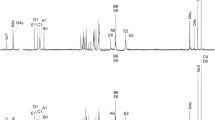Abstract
Comparison of two strains ofHistoplasma capsulatum yielded data differing only in quantification, and the constituents observed and identified were galactose, glucose, mannose, glucosamine and amino acids.
A comparison of hydrochloric acid and formic acid hydrolyses ofH. capsulatum fractions indicated hydrochloric acid to be of more value than 88 per cent formic acid hydrolysis for composition analyses. The removal of formyl esters from formic acid hydrolysates was found necessary and was accomplished byN HCl hydrolysis for 30 min. Two derivative artifacts were observed with formic acid hydrolysis; D-1, which was refractory to subsequent HCl hydrolysis, and D-2, which disappeared after HCl hydrolysis. Another artifact, D-3, was observed with 6N HCl hydrolysis of histoplasma cell wall fractions. The following conditions of hydrolysis were found to be useful: (1) glucose release was measured after hydrolysis inN HCl for 4 hr; (2) glucosamine release was measured after hydrolysis in 6N HCl for 9 hr; (3) amino acid release was accomplished by 6N HCl hydrolysis for 18 hr; and (4), hexoses released were determined by gas liquid chromatography (GLC) after hydrolysis in bothN HCl and in 88 per cent formic acid for 24 hr, followed byN HCl for 30 min.
Several different types of carbohydrate polymers have been reported in the parasitic yeast form ofH. capsulatum. There is general agreement on the occurrence of amino acids as protein (8, 12, 13), chitin (7, 19) and several hexoses, including glucose and glucosamine, which are found in cell wall polymers (7, 8, 11–16, 19, 20, 24). The presence of uronic acid was also reported (14, 15), but not confirmed, by Domer, Hamilton & Harkin (8), and mannose was not found by all investigators (12).
We undertook a study of graded acid hydrolyses and of composition analysis of the autolysis products of the yeast form by various procedures in order to add further to the above information.
Similar content being viewed by others
References
Anderson, K. L. & S. Marcus (1968) Sporulation characteristics of Histoplasma capsulatum. Mycopath. Mycol. Appl. 36: 179–187.
Anderson, K. L. & S. Marcus (1969) Variability in virulence of strains of Histoplasma capsulatum. Amer. Rev. Resp. Dis. 99: 608–609.
Applegarth, D. A. (1966) An unusual amino sugar derivative from the cell wall of Penicillium notatum. Nature 212: 434–435.
Applegarth, D. A. (1967) The cell wall of Penicillium notatum. Arch. Biochem. Biophys. 120: 471–478.
Applegarth, D. A. & G. Bozoian (1967) Artefact of hydrolysis of glucosamine derivatives. Nature 215: 1328.
Bartnicki-Garcia, S. (1968) Cell wall chemistry, morphogenesis and taxonomy of fungi. Ann. Rev. Microbiol. 22: 87–108.
Blank F. (1954) On the cell walls of dimorphic fungi causing systemic infections. Can. J. Microbiol. 1: 1–5.
Domer, J. E., J. G. Hamilton & J. C. Harkin (1967) Comparative study of the cell walls of the yeastlike and mycelial phases of Histoplasma capsulatum. J. Bacteriol. 94: 466–474.
Huppert, M. &J. W. Bailey (1963) Immunodiffusion as a screening test for coccidioidomycosis serology. Sabouraudia 2: 284–291.
Kanetsuna, F., L. M. Carbonell, R. E. Moreno & J. Rodrigues (1969) Cell wall composition of the yeast and mycelial forms of Paracoccidioides braziliensis. J. Bacteriol. 97: 1036–1041.
Knight, R. A. & S. Marcus (1958) Polysaccharide skin test antigens derived from Histoplasma capsulatum and Blastomyces dermatitidis. Amer. Rev. Tuberc. Pulm. Dis. 77: 983–989.
Kobayashi, G. S. & P. L. Guiliacci (1967) Cell wall studies of Histoplasma capsulatum. Sabouraudia 5: 180–187.
Labzoffsky, N. A., J. B. Fischer & J. J. Hamys (1957) Studies on the antigenic structure of Histoplasma capsulatum. Can. J. Microbiol. 3: 975–985.
McNall, E. G. (1962) Cell wall constituents of pathogenic fungi. In G. Dalldorf, Fungi and Fungeous Disease. Thomas, Springfield, Ill. p. 139–147.
McNall, E. G., L. J. Sorensen, V. D. Newcomer & T. H. Sternberg (1960) The role of specific antibodies and properdin in coccidioidomycosis. 34: 213–216.
Markowitz, H. (1964) Polysaccharide antigens from Histoplasma capsulatum. Proc. Soc. Exp. Biol. Med. 115: 697–700.
Pappagianis, D., C. E. Smith, G. S. Kobayashi & M. T. Saito (1961) Studies of antigens from young mycelia of Coccidioides immitis. J. Infect. Dis. 108: 35–44.
Percival, E. (1963) Aldonic, uronic, oxaldonic, and ascorbic acids. In M. Florkin & E. H. Stotz, Comprehensive Biochemistry. Elsevier, New York. Vol. 5 Carbohydrates p. 10–95.
Pine, L., C. J. Boone & D. McLaughlin (1966) Antigenic properties of the cell wall and other fractions of the yeast form of Histoplasma capsulatum. J. Bacteriol. 91: 2158–2168.
Salvin, S. B. (1965) Constituents of the cell wall of the yeast phase of Histoplasma capsulatum. Amer. Rev. Resp. Dis. 92: 119–125.
Sawardeker, J. S., J. H. Sloneker & A. Jeanes (1965) Quantitative determination of monosaccharides as their alditol acetates by gas liquid chromatography. Analyt. Chem. 37: 1602–1604.
Steele, R. S., K. Brendel, E. Scheer & R. W. Wheat (1970) Ion-exchange separation and automated assay of complex mixtures of amino acids and hexosamines. Analyt. Biochem. 34: 206–225.
Timell, T. E., C. P. J. Glaudemans & A. L. Currie (1956) Spectrophotometric method for determination of sugars. Analyt. Chem. 28: 1916–1920.
Walter, J. E. & G. B. Price, Jr. (1968) Chemical serologic, and dermal hypersensitivity activities of two fractions of histoplasmin. Amer. Rev. Resp. Dis. 98: 474–479.
Westphal, O. & K. Jann (1965) Bacterial lipopolysaccharides; extraction with phenol-water and further applications of the procedure. In R. L. Whistler & M. L. Wolfrom ed. Methods in Carbohydrate Chemistry. Academic Press, N. Y. 5:83–91.
Author information
Authors and Affiliations
Additional information
This investigation was supported by National Institute of Allergy and Infectious Diseases Research Grants AI-08359 and AI-01659.
Supported by National Institute of Allergy and Infectious Diseases Postdoctoral Fellowship 5-FO2-AI-32, 422.
Rights and permissions
About this article
Cite this article
Anderson, K.L., Wheat, R.W., Conant, N.F. et al. Composition of the cell wall and other fractions of the autolyzed yeast form of Histoplasma capsulatum. Mycopathologia et Mycologia Applicata 54, 439–451 (1974). https://doi.org/10.1007/BF02050050
Accepted:
Issue Date:
DOI: https://doi.org/10.1007/BF02050050




